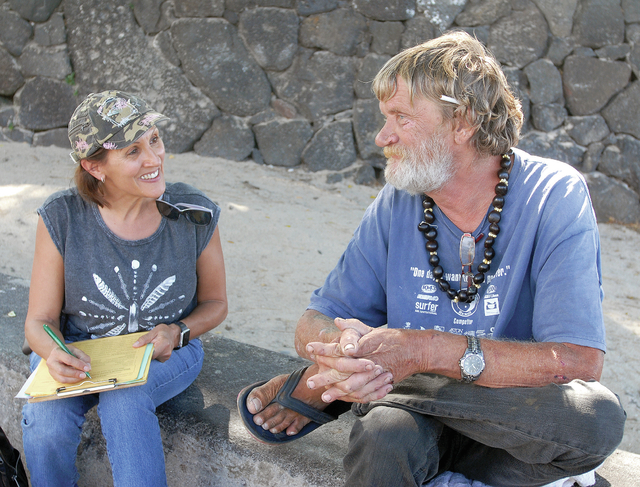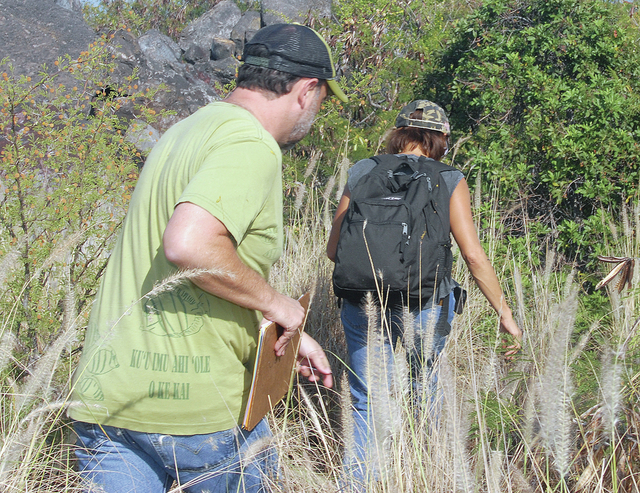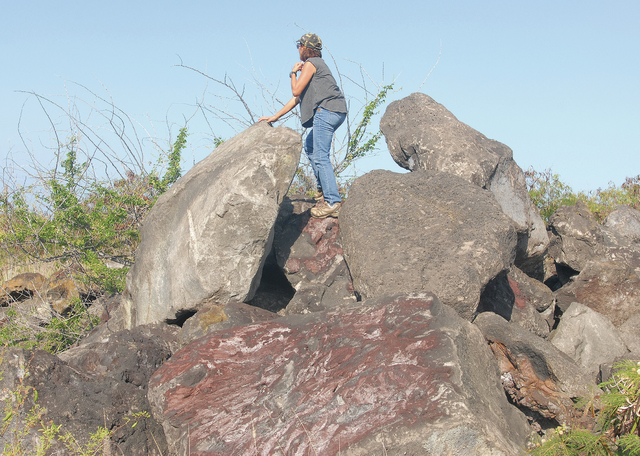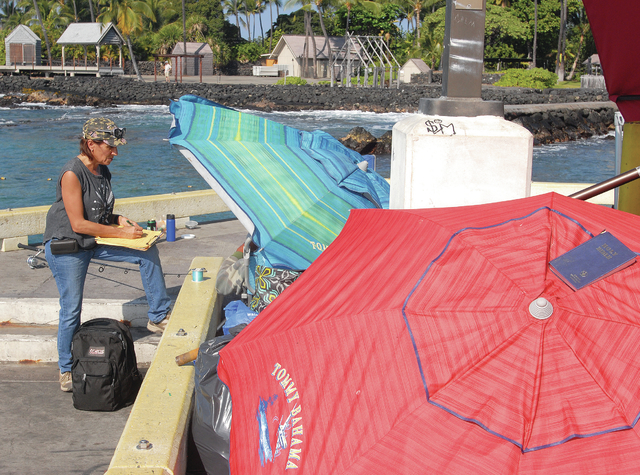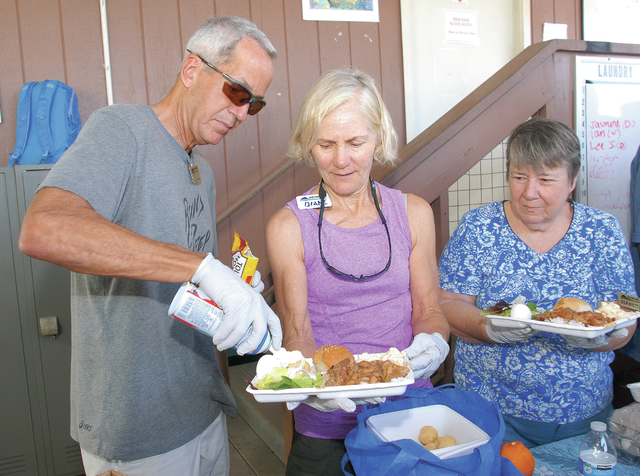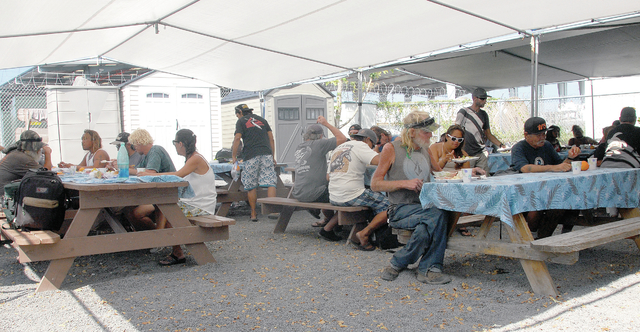KAILUA-KONA — For one week every January, a handful of volunteers roam over the hills and into the bush, through the lava tubes and onto the beaches, scouring every secluded corner of Kona on the hunt for Hawaii Island’s most
KAILUA-KONA — For one week every January, a handful of volunteers roam over the hills and into the bush, through the lava tubes and onto the beaches, scouring every secluded corner of Kona on the hunt for Hawaii Island’s most elusive, and often most desperate, population — its homeless.
A subset of roughly 40 HOPE Services employees and community helpers in West Hawaii, who offer assistance in various capacities, rise each day before the sun in service of a crude census known as the Point-in-Time Count — a loose, data-based snapshot of sheltered and unsheltered homeless individuals across the island on one specific night.
The process can be dangerous, and even Kona’s most seasoned homeless outreach workers won’t venture into certain areas without police escorts — namely established homeless camps off the beaten path, which can be hotbeds of open drug use and sexual exploitation. Even in public spaces where danger isn’t prevalent, if it exists at all, the count is rife with challenges.
No one knows that better than Linda Vandervoort — an independent outreach worker supported by Living Stones Church, relied on and respected by the professionals at HOPE — who is acquainted so well with many of Kona’s homeless that she can recognize them from a quarter mile away, even with their backs turned to her.
“I do (most of my work) on my own, and I like that because I don’t have all the paperwork, and I can color outside the lines when necessary,” Vandervoort explained. “We’re going to get a lot of people who don’t want to give their information. Many unsheltered are anti-government.”
Riding out
Wednesday morning’s portion of the count began at 5:45 a.m. in the parking lot of the Friendly Place, located on HOPE’s campus in the Old Kona Industrial Area.
Charlotte Kim — part of HOPE’s housing department for the last five months, who doesn’t typically engage in initial outreach but was filling in for another employee called away for family reasons — was the driver of the van.
She was joined by Vandervoort and Elizandra Hille, a Brazilian member of Youth With a Mission, who is preparing for a medical discipleship that will carry her to various isolated and impoverished islands around the world in the coming years.
A second van with only one HOPE employee and one volunteer also loaded up and headed to a different portion of the island.
The canvassing began at local department and grocery store parking lots. Like the Old Airport Park, these areas are hit early and often by PIT counters throughout the week, as they’re frequently used as places of respite by homeless families and individuals fortunate enough to own a car.
Even in the K-Mart parking lot, where security risks are minimal, Vandervoort proceeded with caution.
She surveyed the lot, looking for tell-tale indicators that a vehicle was being utilized as a residence — cracked or propped-up windows allowing for ventilation, covered windshields, belongings piled in front seats or only one visible headrest, indicating the other was down because someone was reclining in the seat.
She spotted a promising candidate and headed over.
“Hang back,” she said.
It’s better to approach with only one person, she explained, to minimize anxiety for the vehicle’s resident and avoid making someone feel as though counters are ganging up on him or her.
Vandervoort took a wide berth, announcing herself instead of knocking on the windows, which she said can be interpreted as overly intrusive.
“Hello. My name is Linda. I’m with HOPE Services this morning and I was wondering if I could ask you a few questions?” she said loudly, but not yelling. “I’ve got juice and water. Can I talk to you for a minute?”
Her methods have been developed over four years of experience and are informed by the knowledge of other counters, which is accumulated and implemented to improve methodology year-to-year.
“Our processes have come from trial and error,” said Ipo Morgan, West Hawaii Director at Hope Services. “This year, we’ve been really fortunate and have not run into really hostile interactions. Most interactions (we have) with the homeless population are peaceful.”
Vandervoort’s offerings — juice and water and granola bars — are a way to break the ice, and every PIT Count van that heads out throughout the week is stocked with them. When she’s out on her own ministries with the homeless, Vandervoort also keeps a pack of cigarettes in her car, although she doesn’t smoke.
A kindness, she explained, can often go a long way toward opening people up.
A woman in the passenger seat of an older sedan, wrapped in a blanket, sat up to the sound of Vandervoort’s inquiry, but promptly waved her off. This time, the handouts didn’t serve their purpose.
Vandervoort decided not to press the issue.
“She just wants to sleep,” Vandervoort said, as she walked back toward the van. “I’m going to count her anyway, because we still count if they refuse. So what I do is I just get a basic description and location, that kind of thing. So this person, who was most likely in the same situation on Sunday, is going to get counted.
“That’s actually protocol.”
A delicate approach
The survey, while conducted over the course of a full week, involves questions regarding only whether or not a person was without shelter on one night. In 2017, the night in question was Sunday, Jan. 22, the same evening the sheltered count took place in West Hawaii.
As the team branched out to the Safeway and Walmart parking lots in hopes of encountering more homeless before they scattered for the day, other intricacies of the process became evident, many of them involving the terminology employed.
The word “homeless” was rarely used, as Kim explained that many transient individuals may be in denial about their situations.
“That’s when I kind of go into using different terminology, such as are you sleeping outside, or are you unsheltered,” Vandervoort said.
Some of the same problems are encountered when counting throughout southern portions of the island, such as Ocean View, where many people may own land and/or have four walls and a roof. That doesn’t necessarily disqualify them from being counted, however, depending on the circumstances of their situations.
“We’ve learned to not ask if they’re homeless. They may own property that (they consider) their home,” Morgan said. “And it could be, I don’t want to say insulting, but you’re implying they’re homeless. But according to sub-standard living (conditions), like being without running water or electric, that is considered homeless.”
Vandervoort, Kim and Hille continued to rack up their tallies, handing out juice and granola bars, and filling out paperwork. After the parking lots were covered, the van made its way to Keauhou Bay and down Alii Drive back to the HOPE campus.
By the time the count had wrapped up, their efforts had identified 27 unsheltered homeless individuals.
“It was a good day,” Vandervoort said.
Uncertain nature of the count
The PIT Count is often criticized for its inaccuracies and accused of under representing various homeless demographics, and by extension, the population as a whole.
Scott Morishige, Gov. David Ige’s coordinator on homelessness, doesn’t just accept those criticisms, but agrees with them. However, he said most people don’t understand the count’s true nature and purpose.
“When looking at the PIT Count, it’s important to realize it for what it is, which is just a snapshot on a particular night,” Morishige said. “It’s a volunteer count and it’s also self-reported, so it definitely has its limitations. I think it’s good as just a general estimate.”
It’s impossible to get a flawless picture of homelessness. Many homeless people move around to survive, are uprooted by theft or danger, are run off by police and business owners, or simply have no desire to be found and bothered.
Sen. Josh Green — who represents Kona and Ka’u, and is the Hawaii State Senate Chair on the Committee of Human Services — said the count is really about identifying trends to help formulate action plans.
The numbers do carry weight in terms of federal funding, but the U.S. Department of Housing and Urban Development (HUD) looks at much more than merely the count, Morishige said. The annual numbers are just one data point, and funding is determined by more than whether homeless numbers rose or fell from one year to the next.
“When you apply for funding from HUD, it’s really a competition with other communities for federal funding. HUD evaluates on more than the number of homeless in a community — like how is a community allocating resource to address homelessness, such as permanent housing solutions,” Morishige explained.
“HUD came up with performance benchmarks over the last year. How long (are people) experiencing homelessness before getting into housing? How long does somebody stay in a shelter? What’s the percentage of people who move out of a shelter into permanent housing? The count (itself) is not necessarily a good barometer of the severity of the problem. You have to look at it in context with other things.”
HUD announced in December it was sending $11.5 million to Hawaii to combat homelessness, up around $150,000 from last year, despite homeless numbers rising by 4 percent statewide between 2015 and 2016.
That money will likely accompany $20.9 million in state funding, requested by Ige in his most recent budget proposal.
The state uses the PIT Count to help determine its policies and funding levels as well, but also looks heavily at data from the Homeless Management Information System (HMIS), a database used by all homeless service providers in Hawaii that tracks every person who utilizes homelessness services over the course of the year.
Methodology still must improve
Despite the additional data and research that accompanies the PIT Count, and the adjustments for funding and services made to account for its inherent flaws that are more or less impossible to address, the count’s drawbacks can potentially impact efforts to combat homelessness in Hawaii in negative ways. That is especially true on neighbor islands.
Hawaii Island’s 2016 PIT Count was 1,394, up from 1,241 the year before.
Under representation of a few key groups is paramount to these concerns — most precisely unaccompanied homeless youths. Only one unaccompanied homeless minor was counted on Hawaii Island in 2016, and the same goes for both Maui and Kauai.
“Often times these are runaways, either from their family or from foster care, and they’re trying to stay under the radar,” Morishige said. “Even if someone were to encounter them, they wouldn’t necessarily admit to being homeless. The PIT Count really is a survey, a self-report. They may not be truthful. Maybe they’re a victim of domestic violence and don’t want people to know what their situation is. Those populations are more prone to be under counted.”
Both Vandervoort and Morgan agreed, and Vandervoort added while the number of homeless youths is probably the hardest for her to predict, in her estimation, “there are dozens islandwide. Easily.”
Servicing the under aged homeless population is complex, as mandatory reporters like HOPE Services aren’t legally allowed to shelter youths because of complications regarding legal guardianship. Instead, they’re required to report them to social services as many are runaways, Morgan explained.
If a child shows up unaccompanied at the Friendly Place for a meal or to use the facilities during operating hours, which run from 8 a.m.-1 p.m., the staff is forced to refuse service. But there are a few workarounds to the system.
“We don’t want to turn anyone away,” Morgan said. “I’ve worked with Linda in the past. After (1 p.m.), she’s brought (homeless minors) over to let them shower and do laundry. We won’t bring them in as consumers, but in some cases they’re allowed to use the facilities. We try to work out of the box in that sense.”
Still, many homeless children have APBs out on them and are afraid to even approach a shelter, even when in dire need of assistance.
Because of that, Toni Symons spent much of her time last year as a grant writer, community engagement coordinator and head of the youth program at Family Support Hawaii drawing up a budget proposal and outlining preliminary plans for a Youth Services Center in Kona.
She said it’s something that’s been discussed on Hawaii Island for the better part of 20 years.
The project was modeled after the YO House on Oahu, a walk-in youth outreach program in partnership with the Waikiki Health Center that offers health care, food, a computer center and a multitude of other services for kids on the street.
“This is exactly what we need in Kona,” said Symons, who now works with Ulu Wini. “We thought, could this finally happen?”
The budget Symons compiled totalled out to roughly $207,000 for the first year, although she said to really accomplish its mission, any youth outreach center in Kona would probably need double that amount.
She contacted Green, who said he fully supports the idea. But he acknowledged the PIT Count tally of one unaccompanied homeless minor on Hawaii Island in 2016 may make it difficult to appropriate the requisite funding, even though more than $32 million is likely to be spent throughout the state in each of the next two years to address Hawaii’s crisis of homelessness.
And as of yet, the proposal for a youth center in West Hawaii has not been submitted to the legislature for grant-in-aid consideration.
“It’s obvious (the governor’s team) is going to have to be flexible and fund programs that ramp up over time. Toni, she has the right concept,” Green said. “At the committee level, I’ve added a bill for an additional $10 million just globally for homeless funding, which I’m hoping will give the governor more latitude to fund more programs. There’s a lot more resources that can be brought to the neighbor islands.”
Symons said if nothing else, the idea may be a catalyst to spark conversation about addressing homeless minors on Hawaii Island. She said all too often, she found herself the only person at the table even asking the question, “What about our youth?”
“It’s ridiculous,” Symons said of the notion that only one homeless child is wandering the Big Island unaccompanied. “(Last year), I worked with at least 15.”
An alternate perspective
Teens aren’t the only homeless demographic that’s learned to be elusive, which makes PIT counters’ jobs all the more difficult.
Kim pulled the HOPE Services van into the Safeway parking lot just as first light crept over the mountain. The lot is one of the most popular spots for the homeless to camp for the evening, as it’s open 24-hours a day and those sleeping there are not liable to be hassled or kicked out.
But by the time the day is in full swing, the homeless are nowhere to be found.
“A lot of people sleep here, but they leave when it’s still dark,” a homeless woman who asked to be described only as Christina, said Wednesday morning. “They leave so nobody sees them. It could be a pride thing, or maybe they got harassed by somebody and they don’t want to be harassed again.”
Christina, in her late 50s, who has lived in her van for the past five years with her second husband, added she’s been yelled at and demeaned numerous times.
People have jeered at her and her husband, demeaning them with phrases like, “Get a job!” or “Why the hell don’t you (expletives) go back to the beach?”
But Christina has a job, she said, and has never used drugs. Her husband, however, is ill and unable to work, so while her income is enough to keep them fed, clothed and the van gassed up, it’s not enough to get them into an apartment.
But she doesn’t feel sorry for herself.
“It’s not like it’s poor thing us,” she said. “We don’t need to pay someone else to get rich. We’d have to work more than one job just to pay the rent and utilities and stuff. We’re fine. We eat. We have a roof.”
Christina was willing and unashamed to participate in the count. She spoke pleasantly with Vandervoort, answering every one of her questions.
Then she finished her thought, providing a different perspective on the financial hardships of trying to survive and thrive despite the crippling cost of living in Hawaii. She even suggested maybe her and those like her aren’t the ones who need to be counted, who need to be helped.
“It’s really not poor thing,” she said. “You guys are the poor things. You got two or three jobs going on. You can’t stay at your houses because you’re too busy working to pay the bills. There’s no time for life.”







